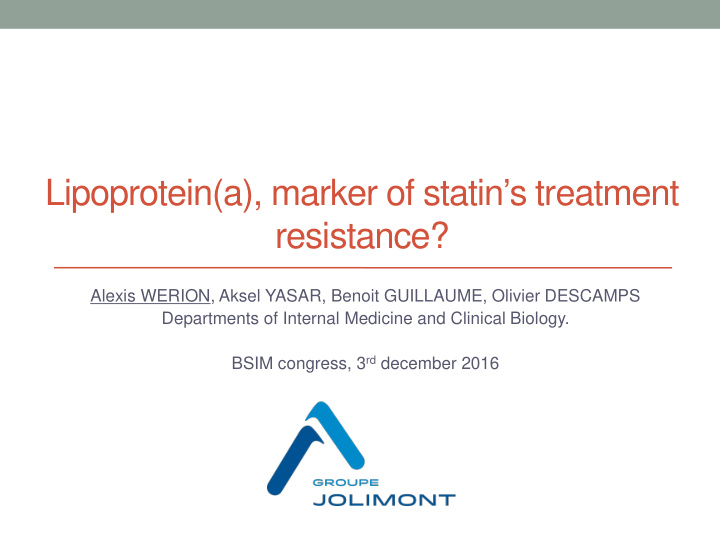



Lipoprotein(a), marker of statin ’ s treatment resistance? Alexis WERION, Aksel YASAR, Benoit GUILLAUME, Olivier DESCAMPS Departments of Internal Medicine and Clinical Biology. BSIM congress, 3 rd december 2016
1 ° What is Lp(a) ? • Composed of 30-40% of cholesterol (LDL-like). • No reuptake possible with LDL receptors • Variability of ApoA via Kringles IV-2 (amino-acids), genetically determined. Modified from Koschinsky and Marcovina, in Nordestgaard et al., Eur Heart J (2010), 31
2 ° Why is Lp(a) so harmfull? • Independant cardiovascular risk factor, independant of LDL-c. • High level is associated with strokes and MI risk. • Mechanistic hypothesis : • Cholesterol as LDLc. • Pro-inflammatory : recruitment of inflammatory cells, and binding of pro-inflammatory phospholipids. • Pro-thrombotic : kringles structure like in plasminogen.
3 ° The concept of pseudo- resistance 1. Statins increases LDL receptors. 2. No reuptake of Lp(a) by LDL receptors. 3. Statins doesn ’ t reduce the Lp(a) level. Statin A : expected reduction of 33% High Lp(a) level Low Lp(a) level Free LDL Lp(a) Free LDL Lp(a) - 33% - 0% - 33% - 0% - - RESISTANCE NO RESISTANCE 17% 29% Kostner and al. 1989. Circulation. 80 : 1313-1310.
Aim of the study Does it exist a pseudo-resistance to statins in the patients with a high level of Lp(a)?
Methods • Retrospective study . • Inclusion criteria : • All the patients with a dosage of Lp(a) in Jolimont Hospital during the years 2015-2016. • Extract randomly an equal number of patients with very high (Lp(a) >100 mg/dL) versus low (Lp(a) < 50 mg/dL) • Exclusion criteria : • Not treated patients (intolerance, no treatment needed). • No value of LDLc found before OR after the treatment (e.g. no follow up).
Cohort characteristics Characteristics Lp(a) < 50mg/dL Lp(a) > 100mg/dL (N = 34) (N = 27) Age - yr 52 +/- 16 53 +/- 15 Male sex – No (%) 16 (47) 9 (33) Body mass index – kg/m 2 27 +/- 8,4 27,3 +/- 5 Cardiovascular risk factors – No (%) Current or recent smoking 5 (15) 0 (0) History of smoking 4 (12) 3 (11) Hypertension 16 (47) 10 (37) Diabetes 6 (18) 6 (22) History of acute coronary syndrome 2 (6) 0 (0) Ischemic cardiopathy (PCI or CABG) 4 (12) 2 (7) Familial history (ACS, Stroke) 15 (44) 13 (48) Familial hypercholesterolemia – No (%) 12 (35) 8 (30)
Cohort treatments Characteristics Lp(a) < 50mg/dL Lp(a) > 100mg/dL (N = 34) (N = 27) « Strong statins » 16 (47) 11 (40) « Moderate statins » 14 (41) 12 (44) « Low statins » 2 (5) 4 (15) Ezetrol 13 (38) 6 (22)
Results Characteristics Lp(a) < 50mg/dL Lp(a) > 100mg/dL (N = 34) (N = 27) Lp(a) – mg/dl 16 +/- 13 162 +/- 40 Cholesterol – mg/dl Before treatment 308 +/- 70 312 +/- 101 After treatment 197 +/- 54 194 +/- 65 HDLc – mg/dl Before treatment 55 +/- 16 56 +/- 14 After treatment 55 +/- 14 56 +/- 16 LDLc – mg/dl Before treatment 224 +/- 65 223 +/- 108 After treatment 114 +/- 50 115 +/- 69 Triglycerides – mg/dl 166 +/- 79 164 +/- 91 Before treatment 138 +/- 102 114 +/- 60 After treatment
400 Expected - 48% Expected - 47% 300 - 47% - 47% LDL-C 200 100 0 Untreated Treated Untreated Treated Lp(a) < 50 Lp(a) > 100
Limitations of the study • Retrospective study. • Not blinded? • Low number of patient with a very very high level (>300mg/dL) of Lp(a) group BUT… • Cohort with high level of LDLc (familial hypercholesterolemia).
Conclusion In a real clinical setting, the present study doesn ’ t show an evidence of pseudo-resistance to statins in patients with high level of Lp(a).
Thanks for your attention
Recommend
More recommend